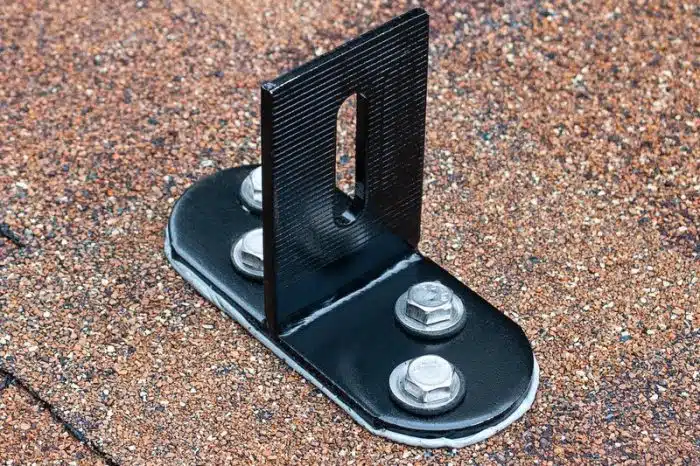
The lack of certified / qualified solar installers is a big storyline in the industry. As more training and apprenticeship programs ramp up, established solar companies can also ease solar installations for installers of all skill levels with newer mounting systems. Many rooftop mounting manufacturers have enhanced their product lines in ways that make installation simpler, faster, and less prone to workmanship errors. Here are some key trends and specific examples from the 2024 Rooftop BOS Buyer’s Guide.
Forget finding rafters
“Installer error typically occurs when searching for the rafter,” says Mikey Wiener, marketing manager with QuickBOLT, “which is a skill developed with time. Knocking for the rafter seems to be the prevailing method and utilizing process of elimination. Vents and other roof alterations will hint toward the rafter locations; installers can pick up these tricks quicker if they spend more time initially being trained.”
QuickBOLT’s new Butyl Bottom Deck Mount, for example, is one of several mounts on the market now that can install anywhere on the roof. No need to locate rafters. The key is the seal the butyl rubber provides. Learn more about the science of butyl rubber solar attachment right here.
“Our rafter mount QB2 is also error-proof by design,” Wiener says. “The mount will physically and visually indicate when you’ve hit the rafter. If you miss the rafter when driving the bolt, the Microflashing will not compress, and the L-foot can easily be rotated. With this failsafe feedback system, you can feel confident knowing you’ve done the job right the first time, reducing the need to return for repairs.”

Minimizing materials
“A critical factor in saving installation time and money is to minimize mounting material and the number of components and fasteners,” says Mark Gies, director of product management at S-5!. “Fewer components, less weight, and fewer fasteners to assemble means less time on the roof and lower installation costs. A rail-less mounting system is about 85% less material than rail-based mounting systems; installers can save significant time on the roof. Less material expedites shipping and further reduces total project costs.”
A great example here is rail-less solar on metal roofs. Metal roofs have structural seams or ribs that function perfectly as rails, so installing rails on top of rails is redundant. The new PVKIT HUR from S-5! is a rail-less metal-roof PV system designed for high wind uplift performance. It’s the first metal roof PV mounting system to achieve FM Approvals toughest PV Standard—FM4478.
In residential, Roof Tech has long been a rail-less mounting proponent. Its RT-APEX rail-less mount can be installed to rafter or deck from a single SKU. So, if you meant to hit a rafter and missed, just insert the four deck mount screws and move on.
Another less considered factor when going away from rail-based systems is the reduction of jobsite obstacles.
“In C&I, select a system that keeps the roof free of trip obstacles, which is safer for crews,” notes Elie, CEO of Sollega. “With ever increasing module size, safety of installation crews is critical, by not having racking covering the roof, they are able to install quicker and with fewer injuries.”
Maximizing groundwork
“Develop repeatable and reproducible steps from start to finish like a factory production line,” Gies says. “Identify and minimize bottlenecks and minimize distances and cycle times across each step. Create visuals to goof-proof the work, such as the right way to prep modules before they are brought up onto the roof. Any progress in shaving off a few minutes from each step will become significant for the overall project.”
Example here is the new NanoRack from SunModo. It is a rail-less option with components that attached directly to the modules while installers are on the ground. “Identify location of the first row of modules and snap a line,” the company explains in the Rooftop BOS Buyer’s Guide. “After modules are positioned in desired roof location, use deck screws to secure NanoPlus mounts to the roof. Assemble the second and additional rows of modules to the array with the patent-pending hook and loop feature with integrated bonding. Modules are automatically aligned with adjacent modules.”
Training courses
Still, no mounting method or product will be foolproof without the proper training.
“Onboarding new hires is like investing, you should invest in training so that the job is done right the first time,” Wiener says. “When training you should utilize the manufacturer’s resources as much as the hands-on field training provided by supervisors/mentors.”
Be sure to check out the training courses and instructional videos that each manufacturer has in its library. We have a link and information on each manufacturer’s training program in this year’s Rooftop BOS Buyer’s Guide.
“Soak in as much knowledge as you can and ask questions,” Wiener says. “Don’t be afraid to fail, but don’t rush with overconfidence.”
— Solar Builder magazine

Leave a Reply
You must be logged in to post a comment.